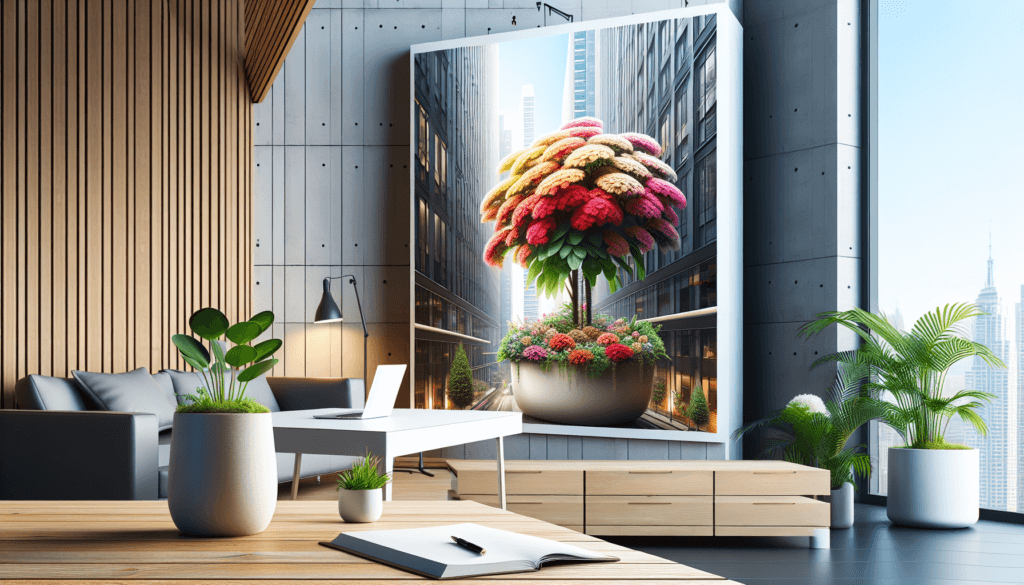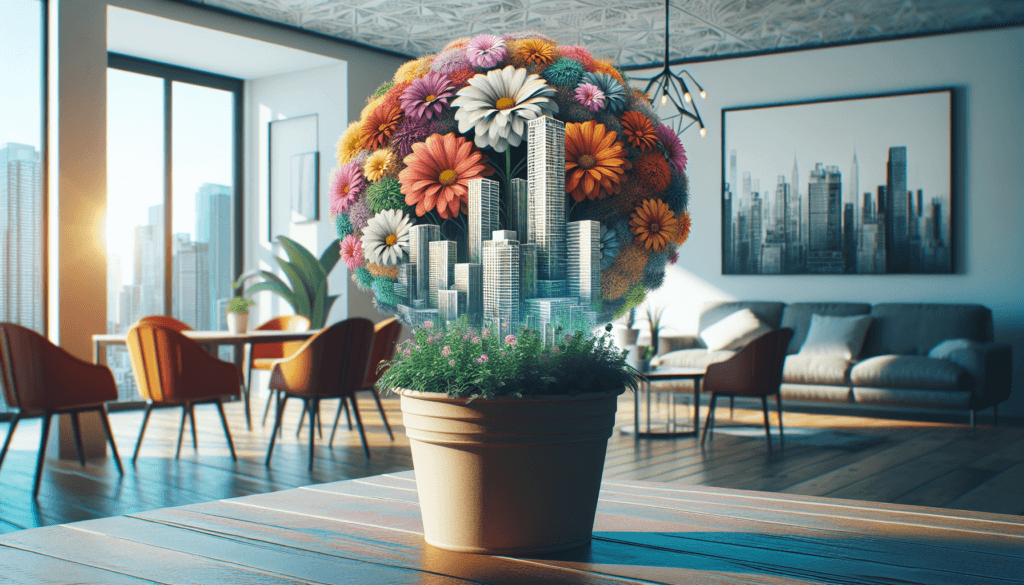Are you a city dweller with a green thumb? Do you dream of having a lush garden, filled with blooming flowers, right inside your home? Look no further! In this article, we will share valuable urban gardening tips that will help you successfully grow flowering plants indoors. From choosing the right plants to providing proper care, we’ve got you covered. Say goodbye to the misconception that gardening is only meant for those with spacious yards, and say hello to the joy of cultivating a beautiful garden in the heart of your urban dwelling. Let’s get started!

Choosing the Right Plants
Consider the Available Space
When choosing plants for your indoor garden, it is important to consider the available space you have. Take into account the size of the space and the specific requirements of each plant. Some plants require more room to grow and spread their roots, while others can thrive in smaller containers or hanging baskets. Assess your indoor space and choose plants that will fit well and have enough room to grow without becoming overcrowded.
Check for Lighting Requirements
Different plants have different lighting requirements, so it is important to check the specific lighting needs of each plant before making a selection. Some plants thrive in bright, direct sunlight, while others prefer indirect or low light conditions. Understanding the lighting requirements of your chosen plants will help ensure that they receive the right amount of light to grow and bloom successfully.
Select Plants Suitable for Indoor Environment
Not all plants are suitable for indoor environments, as some require more space, sunlight, or specific growing conditions. When choosing plants for your indoor garden, make sure to select ones that are well-suited for growing indoors. Look for plants that are known to tolerate lower light levels, thrive in containers, and can adapt to the temperature and humidity levels typically found indoors.
Consider the Maintenance Level
Another important factor to consider when choosing plants for your indoor garden is the maintenance level required. Some plants require more care and attention, while others are more low-maintenance. If you are new to indoor gardening or have a busy lifestyle, it is recommended to start with plants that are easier to care for and require less maintenance. As you gain experience and confidence, you can gradually introduce more demanding plants into your indoor garden.
Preparing the Indoor Space
Evaluate the Light Conditions
Before setting up your indoor garden, it is crucial to evaluate the light conditions in your chosen space. Observe how much natural light the area receives throughout the day and determine if it is sufficient for the plants you intend to grow. If the lighting is insufficient, you may need to supplement with artificial lighting. Understanding the light conditions in your indoor space will help you make informed decisions about plant placement and lighting options.
Clean and Organize the Area
A clean and organized indoor space is essential for a thriving indoor garden. Start by clearing any clutter or unnecessary items from the area to create an unobstructed space for your plants. Dust and clean the surfaces, windows, and walls to ensure that your plants are not exposed to excessive dust or pollutants. A clutter-free and clean environment will not only enhance the visual appeal of your indoor garden but also improve the overall health of your plants.
Ensure Proper Ventilation
Proper ventilation is important to maintain a healthy indoor garden. Fresh air circulation helps prevent the buildup of stagnant air, which can lead to mold growth and other plant health issues. Open windows or use fans to ensure adequate air circulation in your indoor space. Additionally, consider incorporating natural air purifiers, such as indoor plants with air-purifying properties, to further improve the air quality in your indoor garden.
Consider Temperature and Humidity
Temperature and humidity levels play a crucial role in the success of your indoor garden. Most flowering plants thrive in temperatures between 65-75°F (18-24°C). Avoid placing your plants in areas with extreme temperature fluctuations or drafts. Additionally, monitor the humidity levels in your indoor space and adjust them accordingly. Some plants may benefit from a humidifier or regular misting to maintain optimal humidity levels for their growth and development.
Providing Adequate Lighting
Understanding Light Intensity
Light intensity is a critical factor in the growth and blooming of flowering plants. Some plants require bright, direct sunlight for several hours a day, while others can thrive in lower light conditions. Understanding the different light intensity requirements of your chosen plants will help you determine the best locations for them in your indoor space and the type of lighting they may need.
Choosing Between Natural Light and Artificial Lighting
Natural light is often the ideal choice for indoor gardening, as it provides a full spectrum of light that plants need for photosynthesis. However, not all indoor spaces receive enough natural light to sustain plant growth. In such cases, artificial lighting can be used to supplement or completely replace natural light. LED grow lights and fluorescent lights are popular choices for indoor gardens as they emit the necessary wavelengths for plant growth.
Selecting the Right Light Bulbs
When using artificial lighting for your indoor garden, selecting the right light bulbs is essential. LED grow lights are energy-efficient and can be adjusted to emit specific wavelengths that promote plant growth. Fluorescent lights, specifically T5 or T8 bulbs, are also suitable for indoor gardening and provide a good balance of light intensity. Avoid using incandescent bulbs as they generate too much heat and can damage your plants.
Positioning the Lights Correctly
Proper positioning of lights is crucial to ensure that all parts of your plants receive adequate light. Place the lights at an appropriate distance from the plants, considering their light intensity requirements and the size of your indoor space. Adjustable hanging fixtures or shelving systems are great options for providing flexible light positioning. Regularly monitor the distance and position of the lights to ensure optimal light distribution and minimize the risk of light burn.
Creating a Suitable Soil Mix
Understanding the Importance of Soil
The soil in which your indoor plants grow plays a significant role in their overall health and growth. A suitable soil mix provides essential nutrients, proper drainage, and moisture retention, allowing your plants to thrive. Understanding the importance of soil and its impact on plant growth will help you create a suitable soil mix for your indoor garden.
Choosing the Right Soil Components
A good soil mix for indoor plants is typically made up of a combination of organic matter, such as compost or peat moss, and inorganic matter, such as perlite or vermiculite. Organic matter improves the soil’s fertility and water retention ability, while inorganic matter ensures proper drainage. Depending on the specific needs of your plants, you may need to adjust the ratios of organic and inorganic matter in your soil mix.
Balancing Drainage and Moisture Retention
Proper drainage is crucial for preventing waterlogged soil, which can lead to root rot and other plant diseases. On the other hand, sufficient moisture retention is necessary to ensure that your plants have access to water when needed. Strike a balance between drainage and moisture retention by adjusting the composition of your soil mix. Regularly check the moisture levels in the soil and adjust your watering routine accordingly.
Sterilizing the Soil Mix
Sterilizing the soil mix before using it in your indoor garden helps eliminate pests, pathogens, and weed seeds that can harm your plants. There are several methods for sterilizing soil, including baking it in the oven or using steam. Follow the appropriate sterilization method for your soil mix to ensure a clean and healthy growing medium for your indoor plants.

Watering and Fertilizing
Determining the Watering Needs
Proper watering is essential for the health and growth of your indoor flowering plants. The watering needs of plants can vary depending on factors such as plant species, pot size, and environmental conditions. Before watering your plants, determine their specific watering needs by checking the moisture level of the soil. Stick your finger about an inch into the soil; if it feels dry, it’s time to water, but if it feels moist, hold off on watering.
Ensuring Proper Drainage
To prevent waterlogging and potential root rot, ensure proper drainage for your indoor plants. Choose pots with drainage holes or use a layer of gravel at the bottom of the pots to facilitate water drainage. When watering your plants, ensure that water flows freely through the drainage holes and does not accumulate in the pot. Remove any excess water to prevent waterlogged soil.
Choosing the Right Fertilizer
Flowering plants require regular fertilization to provide them with the essential nutrients they need to bloom and grow. When choosing a fertilizer for your indoor garden, opt for a balanced, water-soluble fertilizer specifically formulated for flowering plants. Look for a fertilizer with an NPK ratio that suits the needs of your plants. Slow-release fertilizers can also be a convenient option for providing long-term nutrition.
Establishing a Fertilizing Schedule
Establishing a fertilizing schedule will help ensure that your indoor plants receive regular and consistent nutrition. Follow the instructions on the fertilizer packaging for dosage and frequency, but be mindful not to over-fertilize, as this can lead to nutrient burn and damage your plants. Generally, it is recommended to fertilize flowering plants once every two to four weeks during the growing season and reduce fertilization frequency during the dormant period.
Managing Pests and Diseases
Identifying Common Indoor Plant Pests
Indoor plants can be susceptible to various pests, including aphids, spider mites, and fungus gnats. Regularly inspect your plants for signs of pests, such as yellowing leaves, stippling, or sticky residue. Identifying common indoor plant pests early on will help you take prompt action to prevent infestations and mitigate damage to your plants.
Using Natural Pest Control Methods
Implementing natural pest control methods is a safe and effective way to manage pests in your indoor garden. Consider using natural remedies such as neem oil, insecticidal soaps, or homemade plant sprays to deter pests. Encourage natural predators, such as ladybugs or predatory mites, to help control pest populations. Additionally, practicing good hygiene and regularly cleaning plant foliage can prevent pest infestations.
Recognizing Signs of Disease
Diseases can also affect indoor plants, causing leaf spots, wilting, or discoloration. Familiarize yourself with common plant diseases and their symptoms, such as powdery mildew or root rot. Promptly identify and treat diseased plants to prevent the spread of the disease to healthy plants. Isolate infected plants if necessary and consider using organic disease control methods to minimize the use of harsh chemicals.
Implementing Preventive Measures
Prevention is key in managing pests and diseases in your indoor garden. Ensure that your indoor space has adequate ventilation and avoid overcrowding plants, as this can create an environment conducive to pest and disease development. Quarantine new plants before introducing them to your indoor garden to prevent the introduction of pests or diseases. Regularly monitor and inspect your plants for any signs of trouble and take prompt action if necessary.

Pruning and Deadheading
Understanding the Purpose of Pruning
Pruning is the process of selectively removing parts of a plant to shape it, promote healthy growth, and remove dead or diseased foliage. Regular pruning not only helps maintain the desired shape and size of your plants but also stimulates the development of new growth and encourages flowering. Understanding the purpose of pruning will help you confidently and effectively prune your indoor flowering plants.
Learning When and How to Prune
Knowing when and how to prune is essential for proper plant care. Each plant species has its own specific pruning requirements, including the best time of year to prune and the techniques to use. Research the specific pruning requirements of your chosen plants or consult gardening resources for guidance. Generally, pruning in spring or early summer, after the flowering season, is advisable for most flowering plants.
Removing Spent Flowers
Deadheading, or removing spent flowers, is an important task in maintaining the appearance and health of your indoor flowering plants. Removing faded or wilted flowers not only improves the aesthetic appeal of your plants but also redirects the plant’s energy into producing new blooms. Use clean and sharp pruning shears or scissors to carefully cut off the spent flowers just above a healthy leaf node or bud.
Encouraging Growth and Blooming
Pruning can help stimulate growth and promote blooming in your indoor flowering plants. By removing dead or overcrowded branches, you create space for new growth and improve airflow within the plant. Additionally, selectively pruning certain branches can redirect the plant’s energy towards flower production, resulting in more abundant and vibrant blooms. Follow proper pruning techniques to encourage healthy growth and maximize the blooming potential of your indoor plants.
Providing Proper Support and Trellising
Understanding the Need for Support
Some flowering plants, such as vining or climbing varieties, require support to grow upright and maintain their shape. Providing proper support and trellising ensures that your plants grow in a controlled manner, prevents bending or breakage, and allows them to reach their full potential. Understanding the need for support will help you choose the right structures and techniques to support your indoor flowering plants.
Choosing the Right Support Structures
The choice of support structures depends on the specific needs of your indoor flowering plants. Small, lightweight trellises or stakes are suitable for smaller plants or those with delicate stems. For larger or heavier plants, consider using larger trellises, bamboo stakes, or tension rods. Ensure that the support structures are sturdy and properly anchored to prevent them from toppling over or causing damage to your plants.
Training and Securing Vines
If you have indoor plants with vining or climbing habits, proper training and securing of the vines are necessary to guide their growth. Gently guide the vines along the support structures, using soft ties or plant clips to secure them in place. Regularly check the vines and adjust their positioning as needed to ensure they are growing in the desired direction and are properly supported.
Regularly Checking and Adjusting Supports
Monitoring and adjusting the supports for your indoor flowering plants is crucial to ensure their stability and proper growth. As the plants grow and develop, periodically check the supports to ensure that they are still secure and that the plants are adequately supported. Make any necessary adjustments to the support structures as your plants continue to grow to prevent them from becoming top-heavy or leaning to one side.

Encouraging Pollination
Importance of Pollination for Flowering Plants
Pollination is a vital process that facilitates the reproduction of flowering plants, including the production of fruits and seeds. In an indoor setting, manually or naturally facilitating pollination is crucial for the successful blooming and fruiting of your plants. Understanding the importance of pollination will help you implement the necessary techniques to encourage pollination in your indoor garden.
Using Hand Pollination Techniques
Hand pollination involves manually transferring pollen from the stamen (male part) to the pistil (female part) of flowers. This can be done with a small brush or by gently tapping or shaking the flowers to release the pollen. Hand pollination is particularly important for plants that are not self-pollinating or require cross-pollination. Research the specific pollination requirements of your plants and implement hand pollination techniques when necessary.
Attracting Pollinators Indoors
While it may be challenging to attract natural pollinators indoors, you can create a pollinator-friendly environment to encourage their presence. Introduce flowering plants with bright and fragrant flowers to attract bees, butterflies, or other pollinators that can visit and pollinate your indoor garden. An open window or a small fan can also simulate airflow, helping to disperse pollen within your plants.
Promoting Pollination Success
To increase the chances of successful pollination in your indoor garden, consider gently shaking the plants to mimic the natural vibrations caused by wind or insect activity. This can help to release and distribute pollen within the flowers. Ensure that your plants receive adequate light, as this promotes flower production and increases the availability of nectar, attracting pollinators. Creating a conducive environment for pollination will ultimately lead to better flowering and fruiting of your indoor plants.
Maintaining Indoor Garden Health
Regularly Inspecting Plants
Regular inspections of your indoor flowering plants are essential for maintaining their overall health. Look out for any signs of pests, diseases, or nutrient deficiencies. Check the leaves, stems, and flowers for any abnormalities, discoloration, or damage. By catching and addressing issues early, you can prevent the spread of pests or diseases and implement necessary treatments or adjustments to ensure the continued health and vitality of your indoor garden.
Cleaning and Dusting Leaves
Dust and debris can accumulate on the leaves of your indoor plants over time, obstructing their ability to absorb light and perform photosynthesis. Regularly dusting and cleaning the leaves will help improve their efficiency and overall health. Use a soft, damp cloth or a gentle spray of water to gently wipe or rinse off any accumulated dust or dirt. Take care not to damage the leaves or delicate flowers during the cleaning process.
Avoiding Overcrowding
Overcrowding can negatively impact the health and growth of your indoor flowering plants. When plants are placed too closely together, they may compete for light, water, and nutrients, resulting in stunted growth and increased susceptibility to pests and diseases. Give your plants enough space to breathe and spread their roots by allowing sufficient distance between them. Consider rearranging or thinning out plants if overcrowding becomes an issue.
Rotating Plants to Ensure Even Growth
Evenly distributing light is important for ensuring the even growth and development of your indoor flowering plants. To prevent plants from leaning or growing unevenly towards a light source, periodically rotate them. This allows all sides of the plants to receive equal light exposure, promoting balanced growth and even flowering. Regularly assess the direction and intensity of light in your indoor space and adjust the positioning of your plants accordingly.
In conclusion, growing flowering plants indoors can be a rewarding and enjoyable experience. By carefully choosing the right plants, preparing the indoor space, providing adequate lighting, creating a suitable soil mix, and implementing proper watering, fertilizing, and maintenance practices, you can create a thriving indoor garden filled with beautiful blooms. With attention to detail and regular care, your indoor plants will flourish and bring natural beauty into your home or office environment. Happy gardening!


